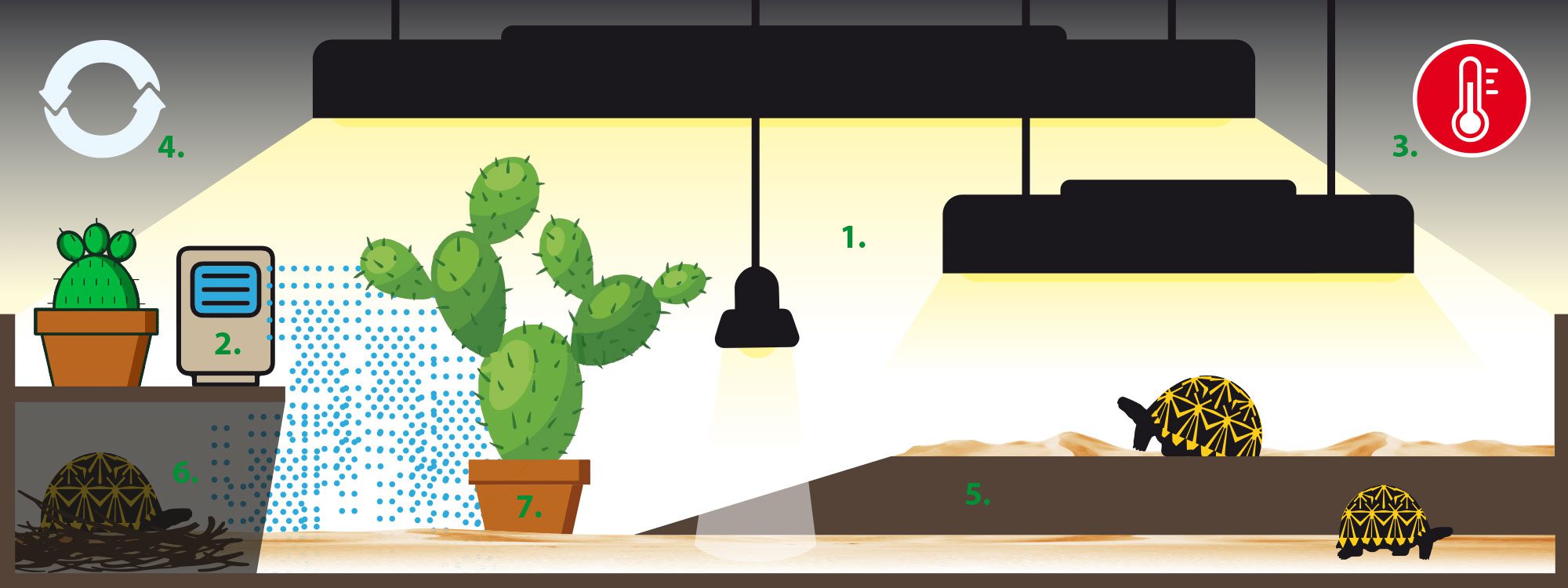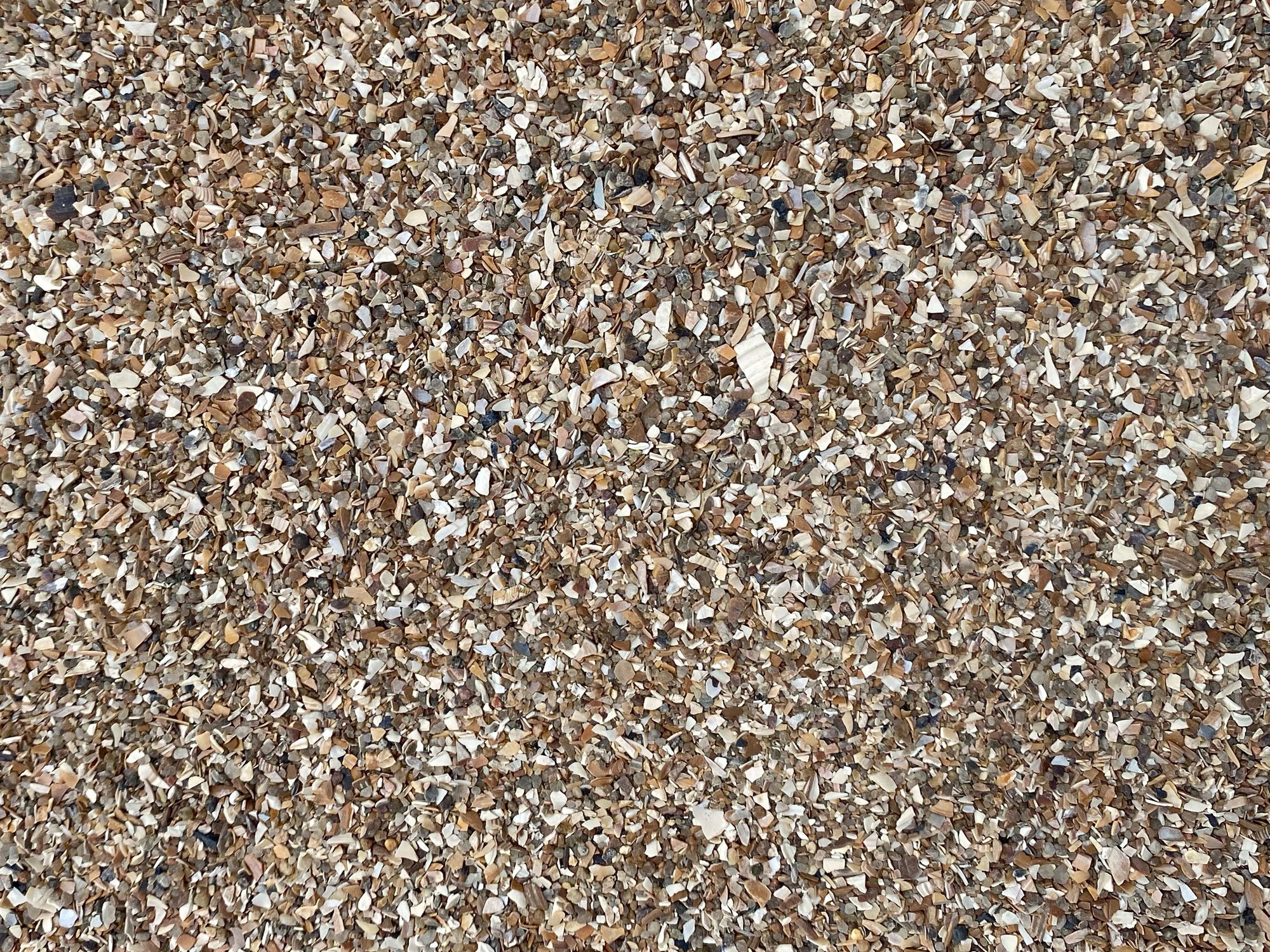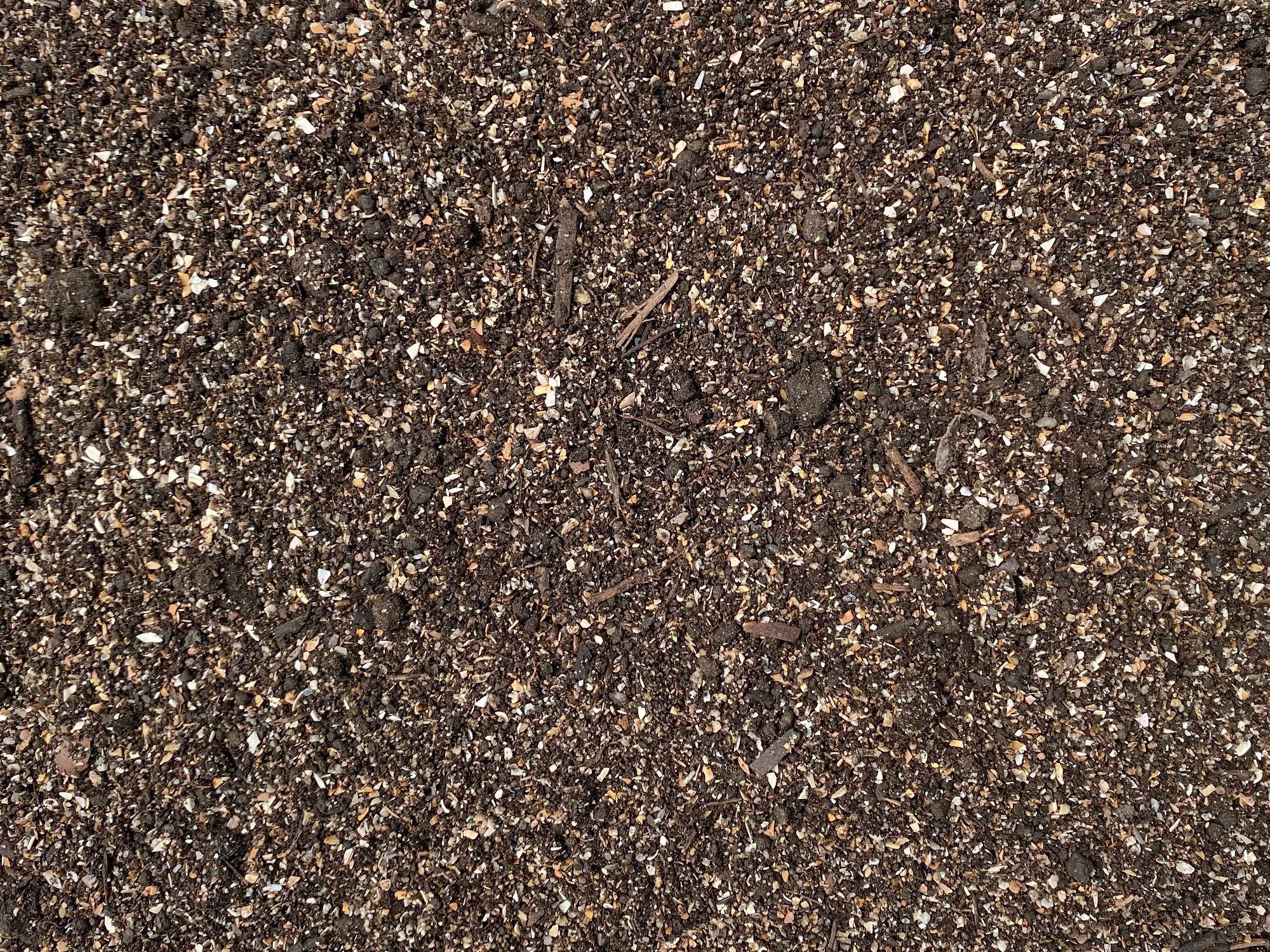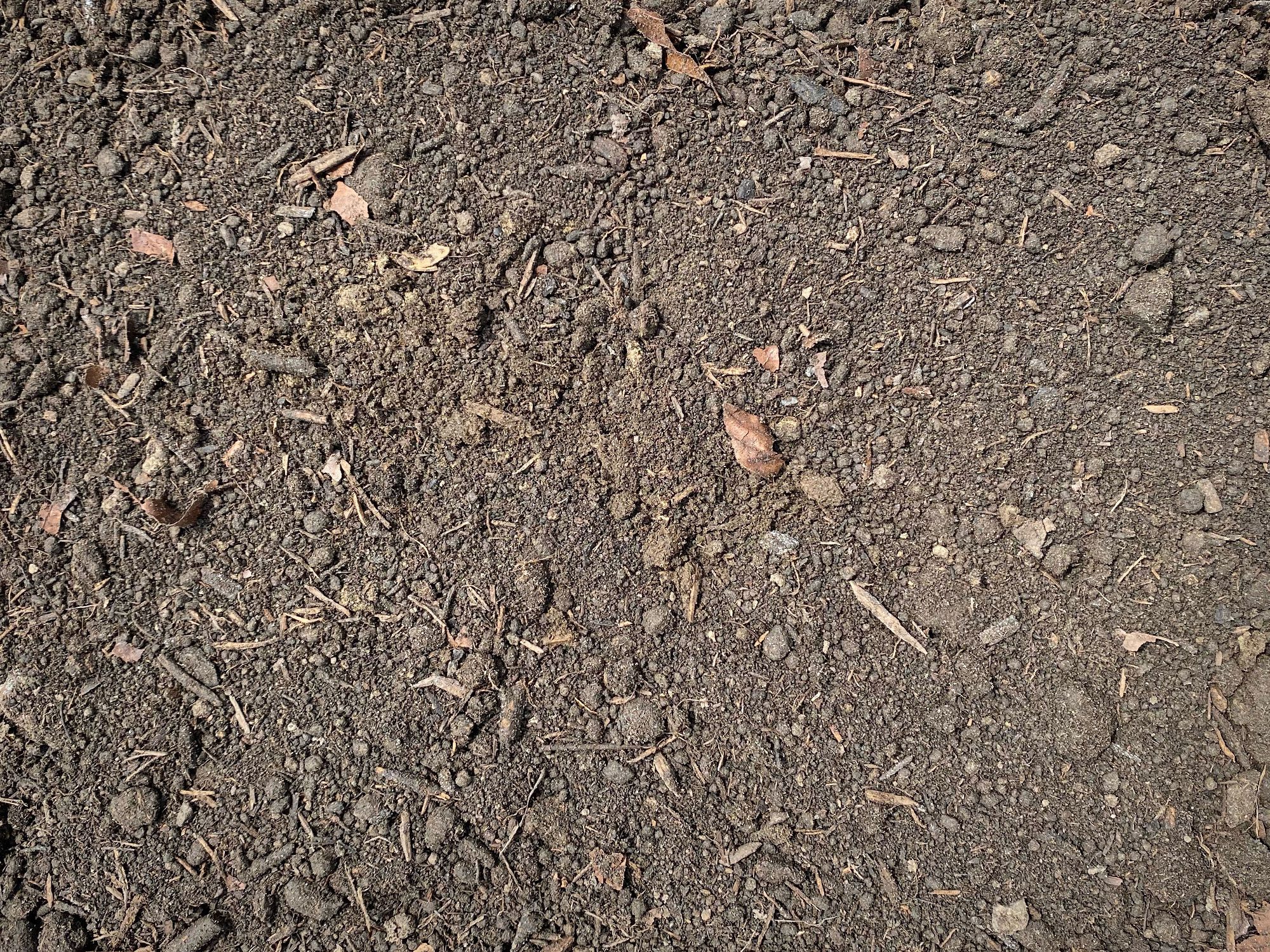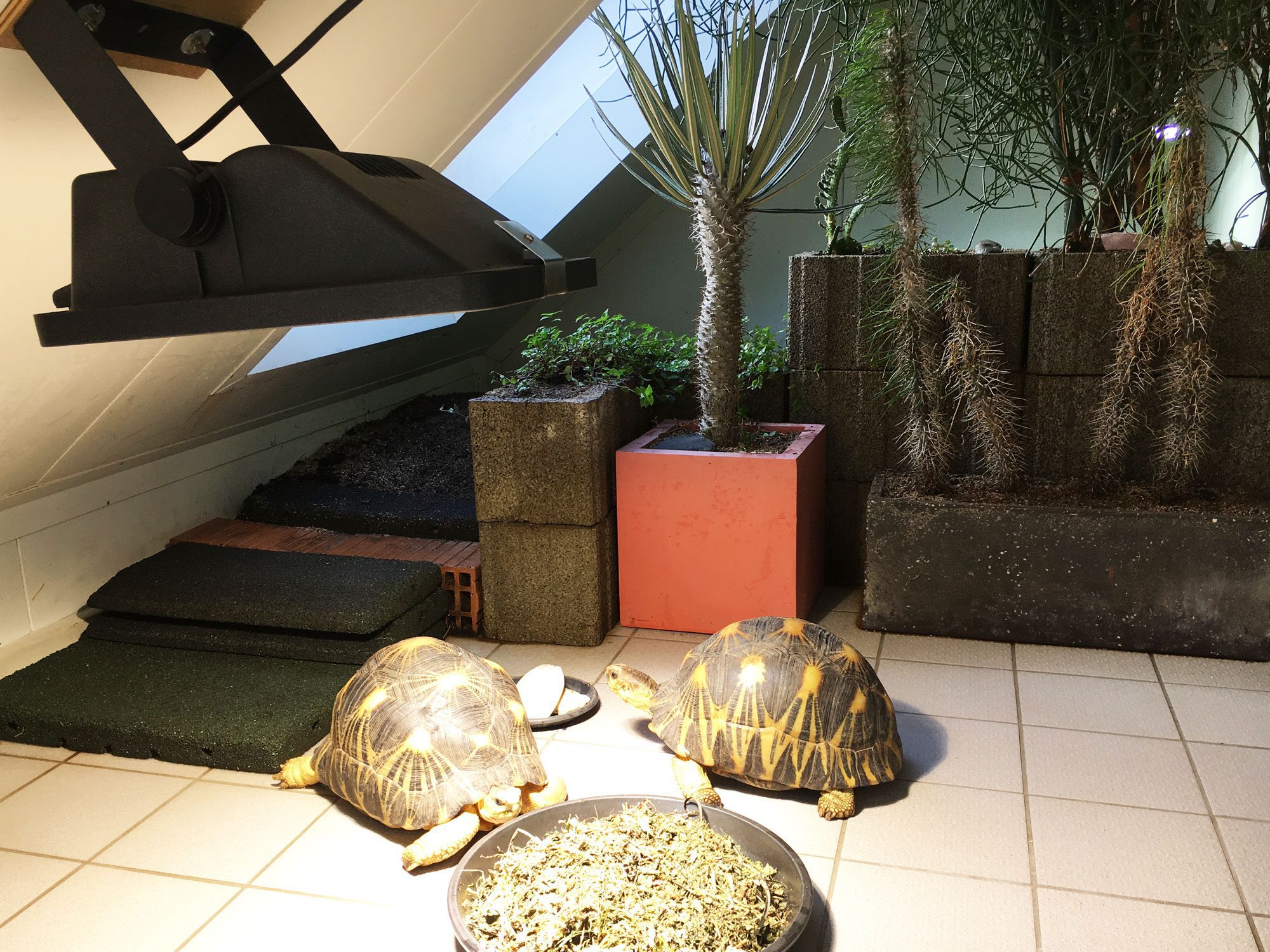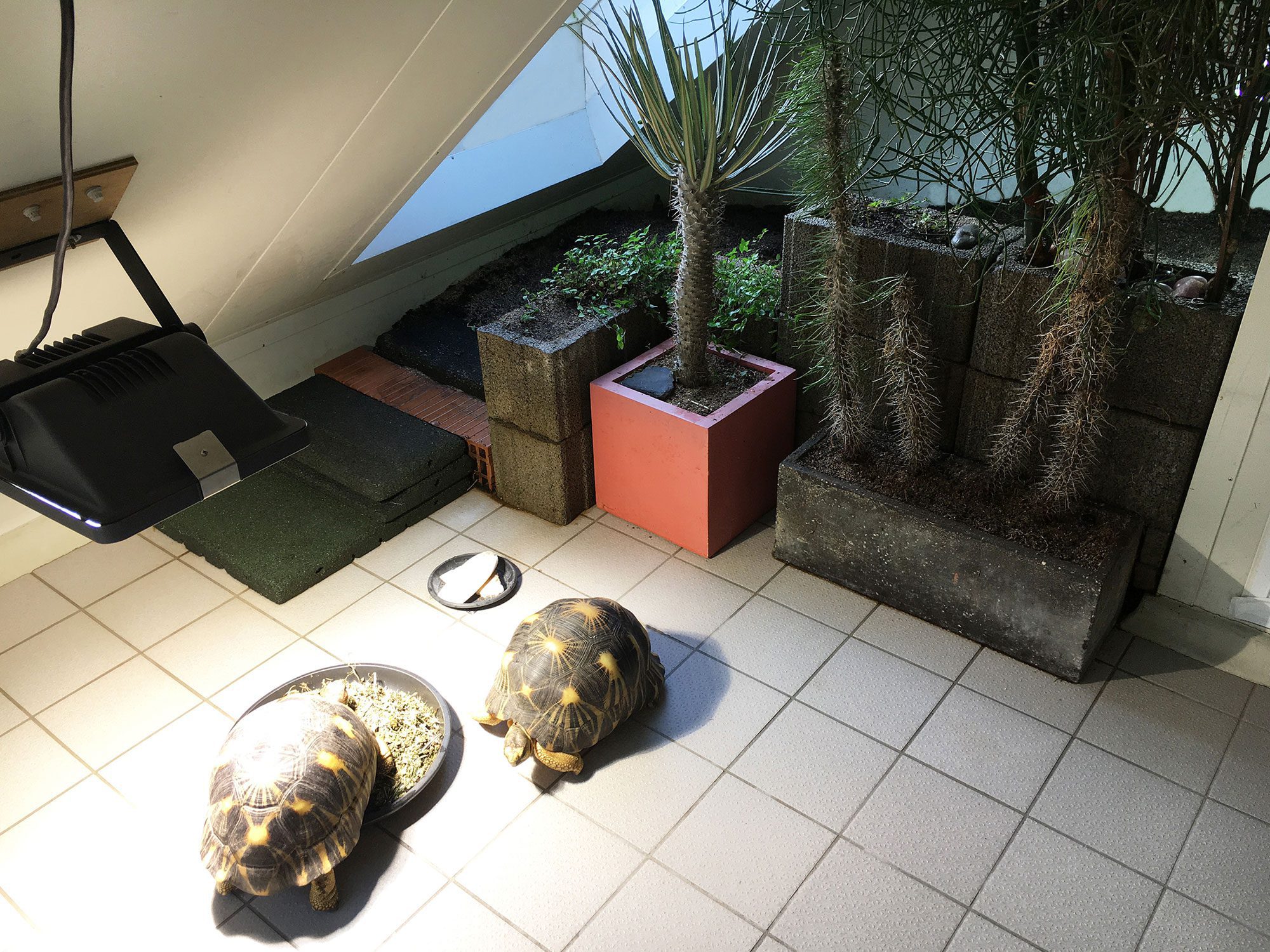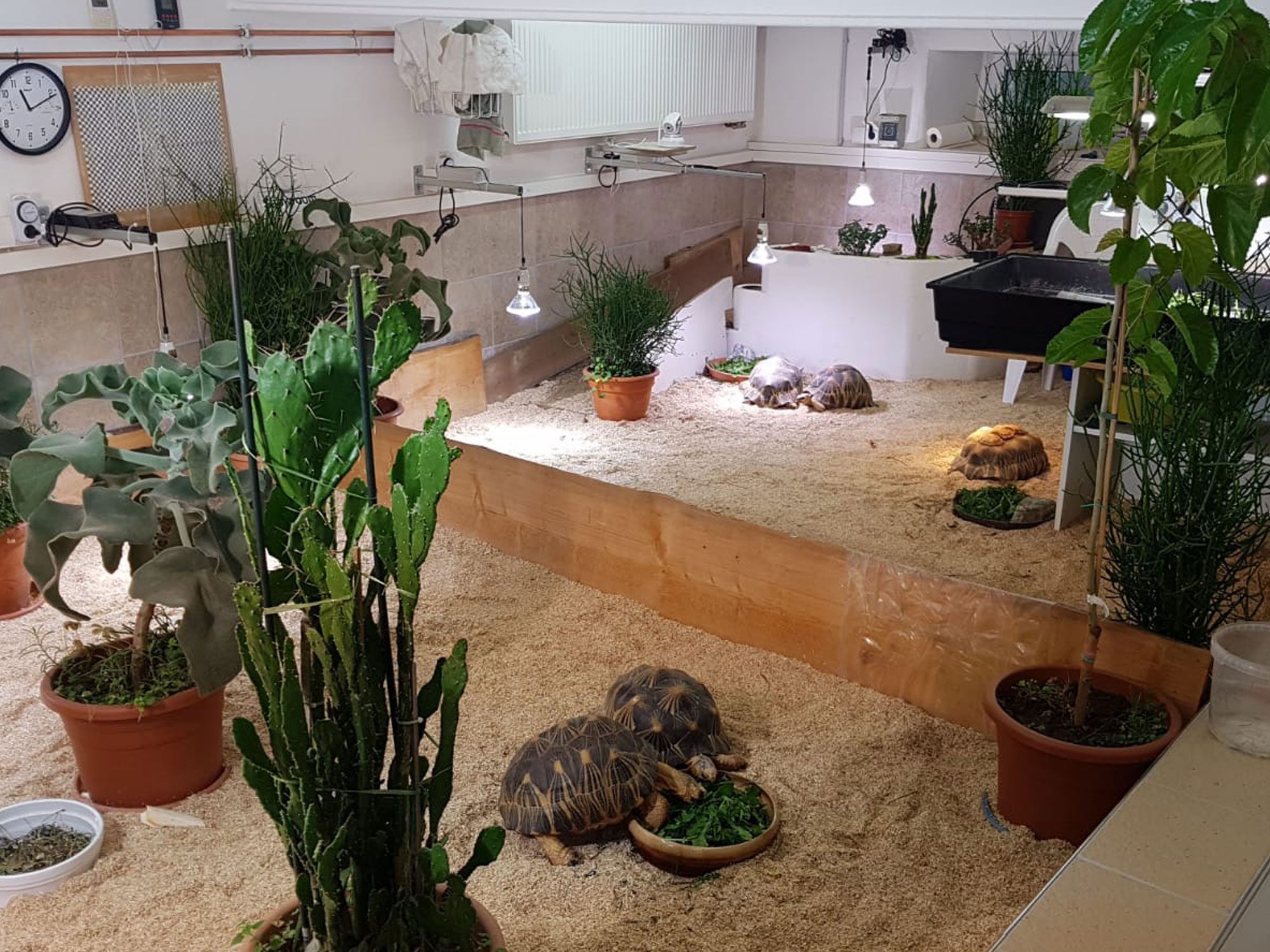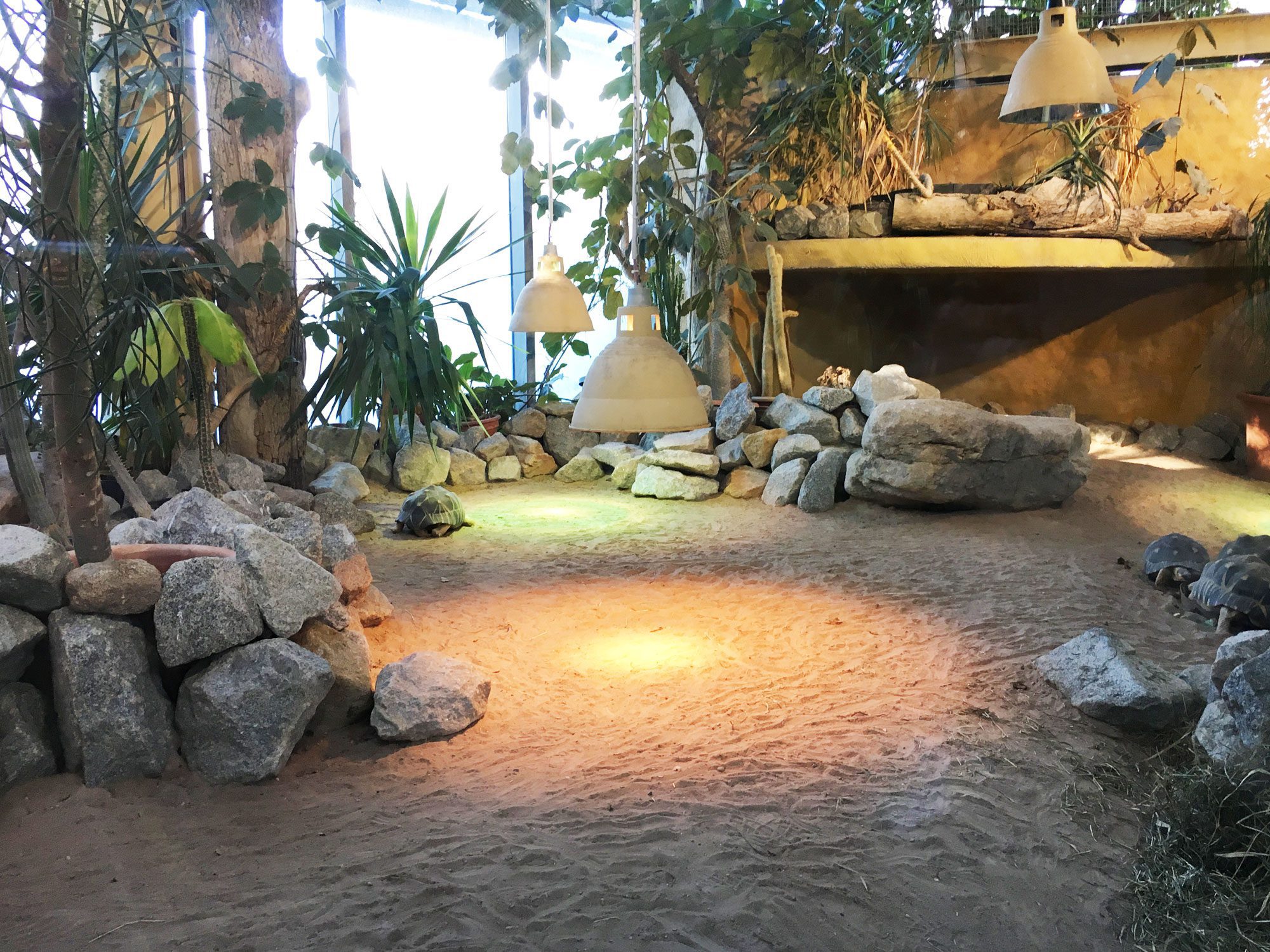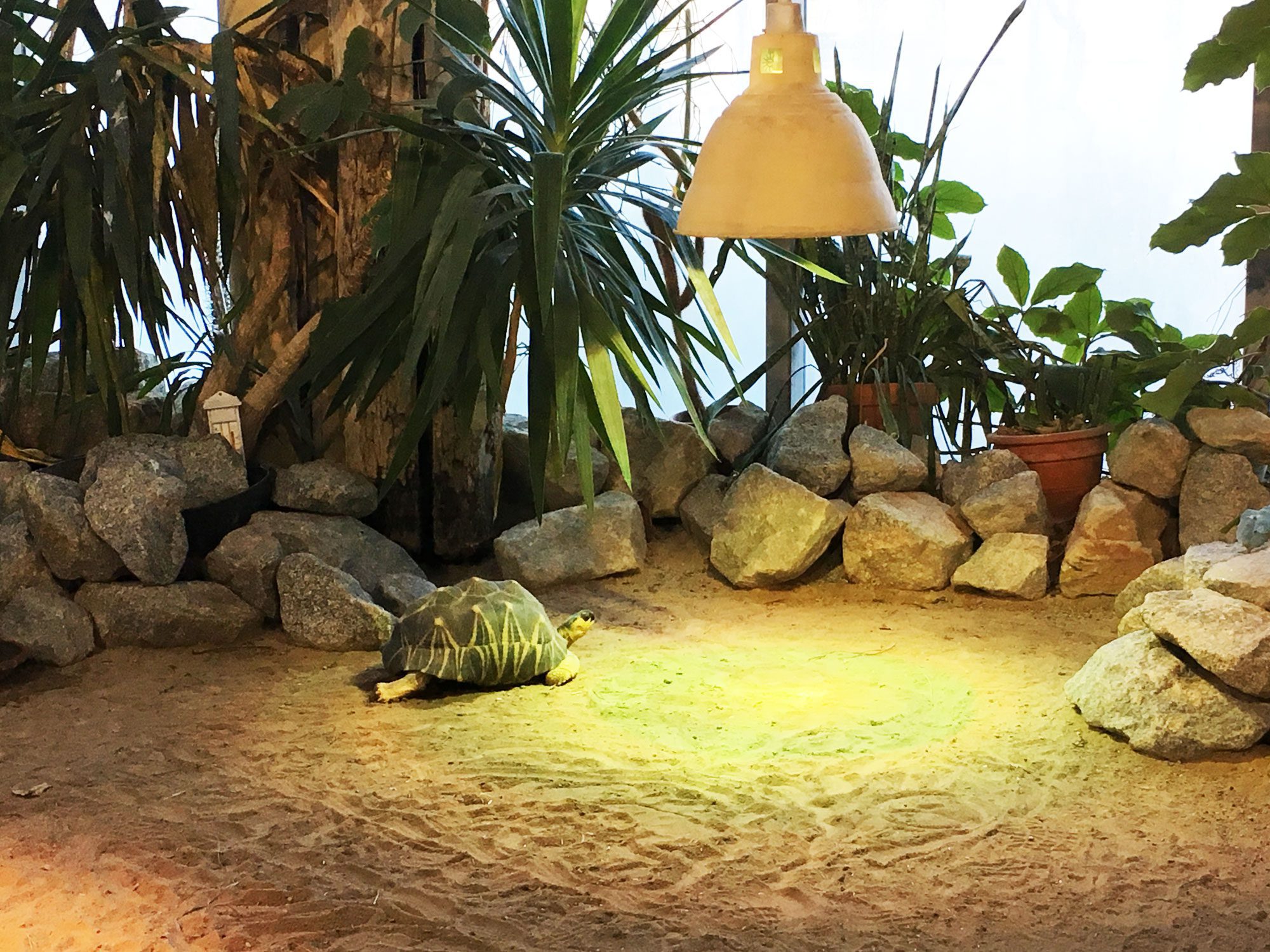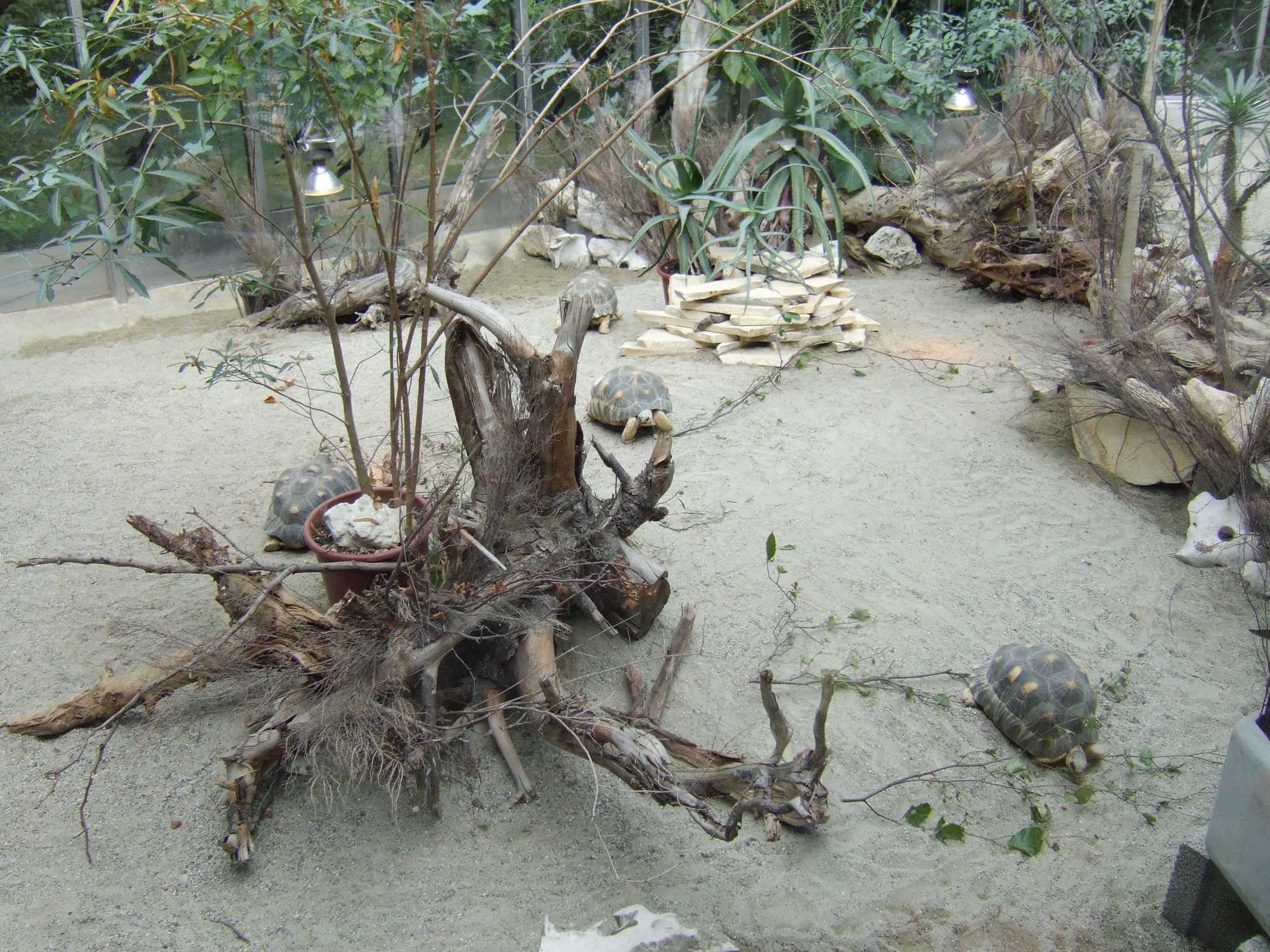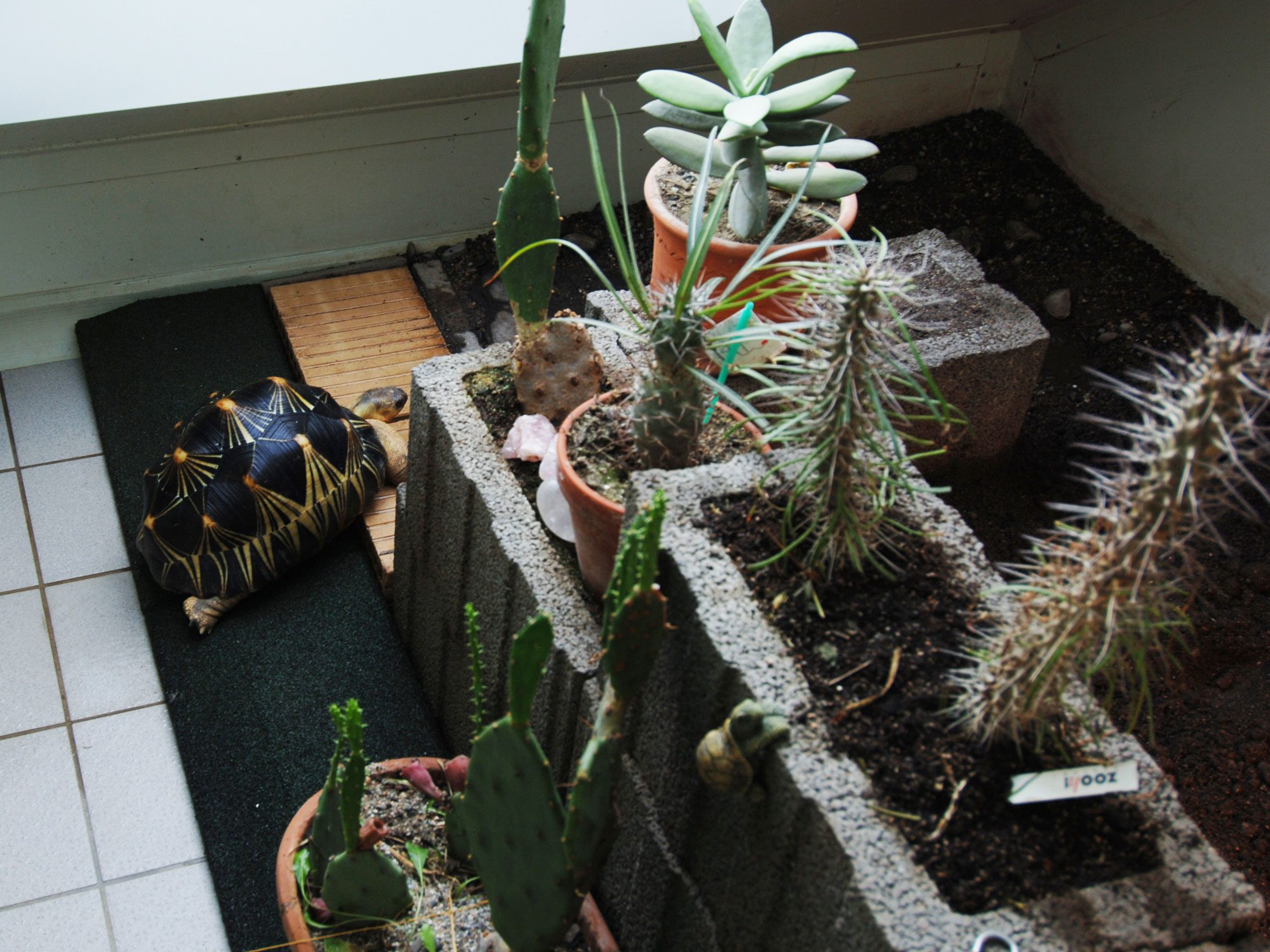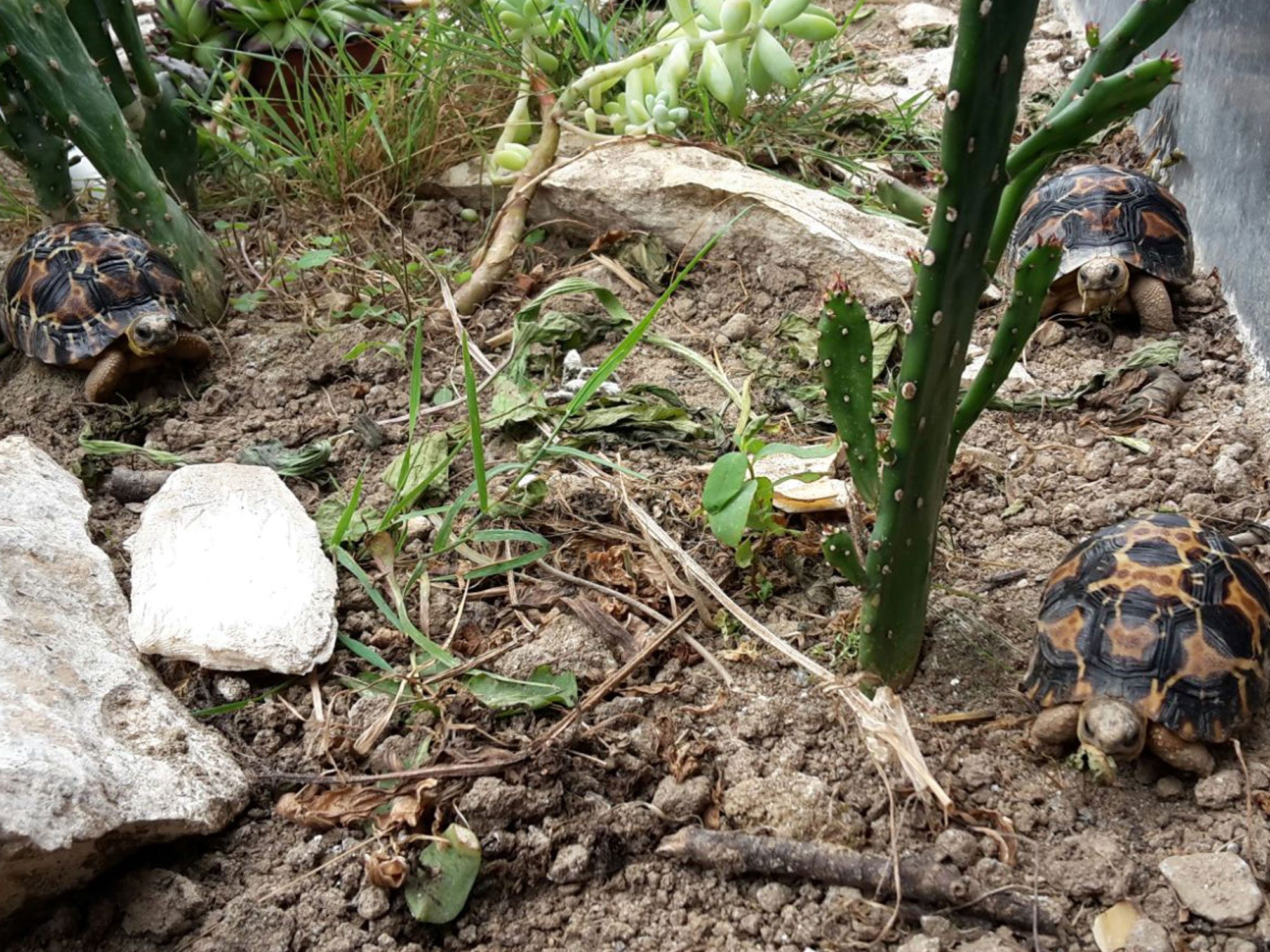Indoor Anlage
Da Astrochelys radiata aus einer subtropischen Klimazone stammt, hält sie keine Winterruhe. Es ist deshalb notwendig Strahlenschildkröten in unseren Breitengraden während der kalten Jahreszeit in einer beheizten und lichtdurchfluteten Indooranlage zu pflegen. Dies ist vor allem bei adulten Exemplaren mit einigem Aufwand an Platz und technischer Ausrüstung verbunden. Grundsätzlich gibt es verschiedene Möglichkeiten von Indoorhaltungen. Besonders bewährt haben sich Indoorhaltungssituationen, die das natürliche Tageslicht integrieren wie z.B. Wintergärten, beheizte Gewächshäuser oder umgebaute Räume mit grossen, hellen Fenstern. Mit einer professionellen Beleuchtung und entsprechender Infrastruktur sind aber auch umgebaute Kellerräume, Zimmer oder Dachstühle möglich. Eine besondere Herausforderung im Indoorbereich ist das Erzeugen einer hellen, warmen Tageslichtsituation mit einem natürlichen Temperaturgefälle während der Nacht und das Halten einer hohen Luftfeuchtigkeit (70-80%). Letzteres ist in einem Wohnbereich aufgrund von Schimmelbildung nur schwer zu bewerkstelligen. Schlüpflinge lassen sich nur in den ersten Lebensjahren saisonal in sehr grossen Terrarien halten. Für Jungtiere haben sich offene und leicht zu reinigende Epoxidharz- oder Plastikwannen in klimatisierten Innenräumen gut bewährt.
Es ist zu beachten, dass Strahlenschildkröten keine Terrarientiere sind. Es ist nicht möglich, Strahlenschildkröten langfristig unter künstlichen Bedingungen gesund zu halten. Deshalb sollten die Tiere in unseren Breitengraden nur im Winter oder bei andauernd schlechter Witterung vorübergehend in einem Innenbereich untergebracht werden. Je weniger natürliches Tageslicht in die Indoorhaltung integriert werden kann, desto weniger lang sollten Strahlenschildkröten darin gehalten werden. Eine Indoorhaltung ist in der Regel nicht wirklich naturnah und somit immer suboptimal. Wir empfehlen Strahlenschildkröten deshalb nie länger als maximal 5 Monate durchgehend in einem Indoorbereich zu halten. Artgerechte Haltungskonzepte für Strahlenschildkröten sind in unseren Breitengraden nur mit kombinierter Freiland- und Innenhaltung möglich.
In der folgenden Darstellung ist die Grundausstattung einer Indoorhaltung für adulte Strahlenschildkröten skizziert.
Substrate
Im küstennahen Habitat von Astrochelys radiata besteht der Boden hauptsächlich aus wasserdurchlässigem, kalkhaltigem Sand und Gestein maritimen Ursprungs. In den Trockenwäldern bildet sich durch herabfallendes und langsam verottendes Laub eine dünne Humusschicht, welche sich mit Sand und verwittertem Geröll vermischt. In der Nähe von Flussläufen gibt es offene und dichte Graslandschaften mit einer Humusschicht, welche Feuchtigkeit in der Regenzeit aufnehmen und speichern kann.
Inspiriert von diesem Terrain verwenden wir sowohl in der Indoor- als auch Outdooranlage folgende Substrattypen: In der Trockenzone, unter Wärmelampen und an Sonnenplätzen hat sich kalziumhaltiger Muschelgrit-/Algritsand in den Körnungen 1-6 mm bestens bewährt. Dieser Muschelsand staubt auch bei grosser Trockenheit nicht und dient nebenbei als Kalziumsupplement. Man kann ihn gut waschen und bei Bedarf auch im Ofen bei 100°C keimfrei machen. In der Übergangszone mischen wir Muschelgrit-/Algritsand im Verhältnis 1:1 mit Gartenerde. Dieses Gemisch verwenden wir auch in tiefen Schichten auf den Legehügeln. Es bietet eine gute Stabilität beim Graben und lässt sich nachhaltig anfeuchten. Durch regelmässiges Umgraben des Legehügels gelangt feuchtes Substrat aus tieferen Schichten an die Oberfläche und die Konsistenz bleibt schön locker, was legebereite Weibchen eher zum Graben animiert. Ausserhalb der Trocken- und Übergangszone verwenden wir reine Gartenerde. Diese sollte jedoch regelmäßig angefeuchtet werden (Luftbefeuchter, Ultraschallvernebler, Besprühen), da sie sonst leicht austrocknet und durch das ständige Begehen und Gewicht der Schildkröten schnell pulverisiert und staubig wird. Bei Jungtieren können in Bereichen mit Gartenerde auch Grasbüschel oder andere geeignete, robuste Pflanzen eingebracht werden.
Die Versteck- und Schlafplätze sind mit Stroh und Laub ausgeplostert, so dass sich die Tiere gut einkuhlen können. Strahlenschildkröten mögen es, wenn während der Nachtruhe rund um den Panzer lockerer, taktieler Widerstand spührbar ist. Es vermittelt ihnen ein Gefühl von Geborgen- und Sicherheit. In freier Natur oder im Aussengehege werden deshalb grosse Grasbüschel, niedriges Buschwerk und Unterholz als Schlafplätze bevorzugt.
Exkremente müssen täglich, grösszügig mit einer Schaufel aus den Substraten entfernt werden. Aufgrund verbleibender Restverunreinigungen, müssen alle Substarte nach einer gewissen Zeit komplett ausgetauscht und recycled werden. Achten Sie immer auf Sauberkeit und Hygiene im Indoorbereich! Da wir eine grössere Gruppe adulter Tiere halten und eine Überbeanspruchung von Substraten vorprogrammiert ist, verzichten wir in einem Grossteil der Innenanlage komplett auf Substrat und halten die Tiere direkt auf einem rutschfesten Fliesenboden, den wir 2x wöchentlich mit einem Schlauch abspritzen und mit einer Bürste leicht reinigen können. Diese teilweise, substratlose Haltung im Indoorbereich ist jedoch nur legitim, weil die Tiere jederzeit auf Bereiche mit Substrat ausweichen können (Legehügel, Schlafbereich) und ein direkter Zugang ins naturnahe Aussengehge besteht, den die Tiere bei schönem Wetter von März bis Oktober täglich selbständig nutzen können.
Orientieren Sie sich bei der Substratwahl am natürlichen Habitat von Astrochelys radiata. Substrate mit den folgenden Eigenschaften sollten unbedingt vermieden werden:
Unsere Indooranlage
Das Innengehege für unsere Strahlenschildkröten ist eine wintergartenähnliche Konstruktion mit einem nach Süden abgeflachten Dach, in welches zwei grosse Fenster eingelassen sind. Da wir in der Zentralschweiz in einer Region mit ziemlich langen und harten Wintern leben, ist das gesamte Schildkrötenhaus mit dicken und wasserfesten Isolationswänden (Grosskühlraum Elemente) ausgekleidet. Auch das Dach ist eine robuste und äusserst schneefeste Konstruktion. Durch die beiden Dachfenster fällt auch in der kalten Jahreszeit und bei bewölktem Himmel immer natürliches Tageslicht. Durch die Glasfenster einfallende Sonnenstrahlen erwärmen das Schildkrötenhaus zusätzlich. Bei einer Raumtemperatur von über 35°C öffnen sich die Dachfenster automatisch um einer Überhitzung vorzubeugen.
Der Boden im Innenraum hat ein leichtes Gefälle und ist mit einem rutschfesten und leicht zu reinigendem Industriefliesenboden ausgelegt. Eine partielle Bodenheizung ist unter dem Fliesenboden eingearbeitet und sorgt während den Wintermonaten tagsüber für eine Raumtemperatur von 20 bis 25°C. Der Innenraum verfügt über einen Wasseranschluss und Abfluss, welche eine leichte und hygienische Reinigung des gesamten Schildkrötenhauses mit dem Schlauch ermöglichen.
Der hintere Teil des Geheges ist mit 5 cm dicken Gummimatten ausgelegt und mit reichlich Stroh bedeckt. Dieser ungeheizte Bereich dient den Schildkröten als bevorzugter Schlafplatz. Damit wir ungestört Reinigungsarbeiten im übrigen Innenbereich durchführen können, trennen wir die Gruppe ebenfalls gerne in diesem Ruhebereich ab.
Im vorderen Teil, unter dem einen Dachfenster ist ein grosszügiger Legehügel (1m x 2.5m) angelegt, welcher für die Schildkrötenweibchen leicht über eine Rampe aus Gummimatten erreichbar ist. Der mit Löffelsteinen abgegrenzte Legebereich ist mit einem Substrat aus Muschelgrit-/Algritsand und Gartenerede gefüllt und über 40 cm tief. Ein Sichtschutz aus Pflanzen sorgt dafür, dass sich die Weibchen beim Brutgeschäft ungestört fühlen. Die Jungtiere sind in grossen, offenen Wannen in der Indooranlage untergebracht und profitieren optimal vom künstlich erzeugten Klima.
Schwere Löffelsteine und grosse Blumentöpfe in denen Futterpflanzen gedeihen, gliedern den Innenraum und dienen den Tieren untereinander als Sichtschutz. Die einzelnen Bereiche können bei Bedarf mit Holzbrettern abgetrennt werden.
An der abgeschrägten Decke ist eine Schienhalterung angebracht an der Kabel und auch zusätzliche Leuchtmittel aufgehängt werden können.
Der Indoorbereich ist mit der Aussenanlage über ein verschliesbares Tor verbunden. Im Sommer können die Tiere selbständig vom Innen- in den Aussenbereich wechseln, so dass wir keine zusätlichen, beheizten Schutzhütten für die adulten Tiere benötigen.
Artgerechte Beispiele für Indooranlagen
Im folgenden Bildkarussell finden Sie zur Inspiration und Nachahmung gute Beispiele von Indooranlagen. Um für die Radiatacommunity eine breite und repräsentative Vielfalt an artgerechten Indooranlagen zu zeigen, freuen wir uns sehr über das Zusenden von weiteren Bildbeiträgen. Alle Beiträge mit mindesten 2000 x 1500 Pixeln (Breite x Höhe) können gerne mit Namen und einem Copyright publiziert werden. Wir danken allen Strahlenschildkrötenhalter*Innen für ihre freundliche Unterstützung!
FAQ zum Themenbereich Innengehege
Grundsätzlich sind Strahlenschildkröten Individualisten und streifen alleine und selbständig durch ihre jeweiligen Territorien. Dabei sind sie nicht auf permanente, dauerhafte, soziale Kontakte mit Artgenossen angewiesen. Saisonal, z.B. zur Paarungszeit oder an geeigneten Wasserstellen, Futter- bzw. Sonnenplätzen, treffen Strahlenschildkröten aber immer wieder auf Artgenossen und zeigen dann ein artspezifisches, interaktives Sozialverhalten. Für die Haltung in menschlicher Obhut bedeutet das, dass man Strahlenschildkröten über einen längeren Zeitraum und vor allem saisonal durchaus einzeln halten kann. Artgerecht wäre aber, wenn man ihnen ab und zu auch Kontakt zu Artgenossen ermöglicht. Astrochelys radiata ist eine eher friedliche Landschildkröte, so dass sowohl Männchen als auch Weibchen problemlos in kleinen Gruppen zusammen gehalten werden können. Bei einer Gruppenhaltung ist jedoch immer auf ausreichend Platz mit Ausweich- und Separationsmöglichkeiten zu achten! Im Hinblick auf die Arterhaltung, scheint das Anstreben von intakten Zuchtgruppen durchaus sinnvoll.
Schlüpflinge von Strahlenschildkröten rotten sich in den Aufzuchtbecken in Verstecken oft dicht zusammen, was manchmal den Eindruck erweckt, dass die Tiere auch die körperliche Nähe zu Artgenossen suchen. Ob Gruppenansammlungen von Jungtieren in freier Wildbahn, z.B. unter verottendem Laub in Trockenwäldern, auch vorkommen ist nicht bekannt. Dies könnte auch eher zufällig sein, weil gute, klimatisierte Verstecke auch in der Wildnis einfach beliebt und gefragt sind.
Diese Frage lässt sich nur sehr schwer beantworten, weil ein Gehege für ein Wildtier grundsätzlich nie gross genug sein kann. Wir bewundern und freuen uns immer sehr über die liebevolle Grosszügigkeit von einzelnen Schildkrötenhalter*Innen, die für ihre wenigen Tiere ganze Innenräume mit angrenzendem Garten zur Vefügung stellen und keine Kosten und Mühen für das Wohlbefinden Ihrer Schildkröten scheuen.
Strahlenschildkröten sind sehr aktive Schildkröten mit einem grossen Bewegungsbedarf. Als grobe Faustregel kann man davon ausgehen, dass die Masse für ein Innengehege mindestens 10x die Panzerlänge in der Länge und Breite betragen sollte. Für ein Aussengehege 20x die Panzerlänge in der Länge und Breite. Für jedes weitere Tier noch 2x die Panzerlänge in der Länge und Breite. Diese Angaben sollten nicht unterschritten werden! Natürlich müssen die Gehegegrössen mit dem Wachstum der Schildkröte immer wieder erweitert werden. Die Gehegegrösse sollte immer ausreichend gross gewählt werden, damit die Schildkröten verschiedene Licht- und Temperaturzonen darin vorfinden können.

